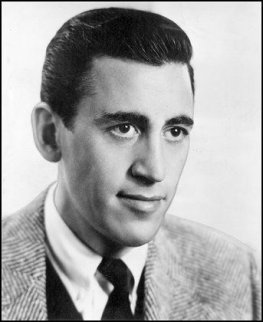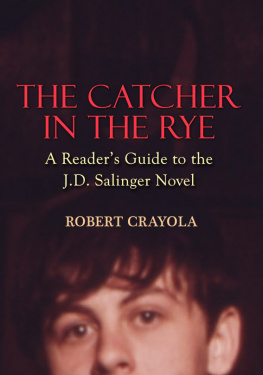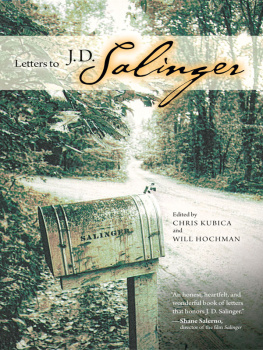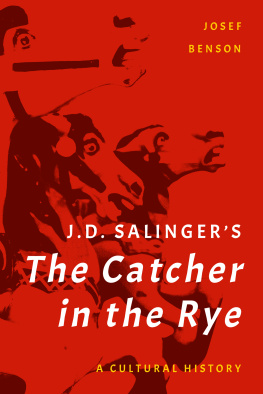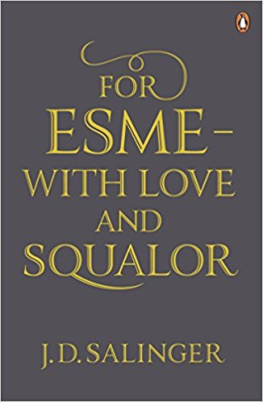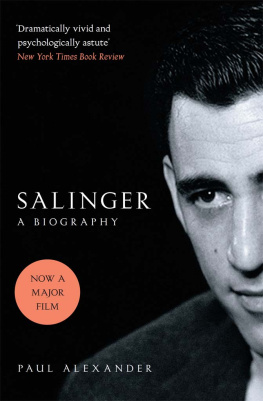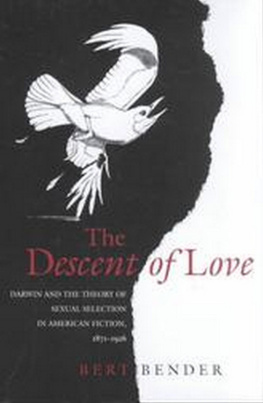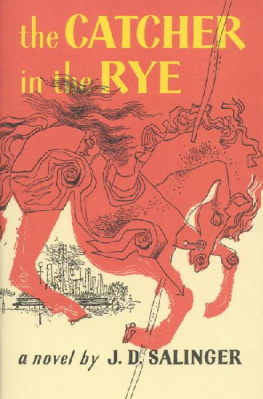

Contents
Good-bye, Holden Caulfield.
I Mean It. Go! Good-bye!
WALTER KIRN
REN STEINKE
CHARLES DAMBROSIO
Salingers Daughter: Whining Bitch
(Or How I Became the Voice of Youth)
EMMA FORREST
ALEKSANDER HEMON
LUCINDA ROSENFELD
AMY SOHN
The Boy That Had Created the Disturbance
Reflections on Minor Characters in Life
and The Catcher in the Rye
JOHN MCNALLY
KAREN E. BENDER
THOMAS BELLER
BENJAMIN ANASTAS
AIMEE BENDER
JOEL STEIN
JANE MENDELSOHN
In memory of Jerome Badanes
Introduction
There are a lot of things that most of us would rather not know about J. D. Salinger. What he eats or drinks. What he wears. What kind of father he is. Or any other of the various sordid details that have surfaced about his personal life in books by Ian Hamilton, Margaret Salinger, and Joyce Maynard. Personally, my interest was never in J. D. Salinger the myth. It was always in J. D. Salinger the writer.
The revelations made about Salingers personal life in these recent books dont affect my reading of his work because finding out who he is cant change my own personal history of discovering Salinger. Reading Salinger for the first time made me excited not only about Salinger. It made me excited about reading. It has now been fifty years since The Catcher in the Rye was published and more than thirty-five years since he published his last book, Raise High the Roof Beam, Carpenters and SeymourAn Introduction, but there is still intense interest in Salinger today.
While the recent coverage in books and magazines on Salinger has focused almost exclusively on his sustained seclusion, his romantic trysts, or his relationship with his children, what seems most interesting now is Salingers profound influence on successive generations of writers. This includes a generation of young(ish) writers who are guiding our literature into the next century, most of whom were born at the time of or after Salinger withdrew from the literary world. But even though Salinger retreated, the writers in our collection were raised on Salinger in the same way that writers in the first half of the twentieth century were raised on Dickens and Twain. Salinger was a literary writer who was and has always been intensely popular.
Nowhere is the passion for Salinger greater than amongst writers. Writers have a different, very sensitive, sometimes quite introspective view of the world that Salinger captured in his work. For many writers, The Catcher in the Rye so defined first-person narrative that it limited the world to a binary option: a writer could embrace Salingers loose, impressionistic, conversational, and above all untrustworthy and unreliable voice, or reject it for crisp, minimalist erudition. There is a cadence to Salingers words, particularly to Holdens speech, that is incredibly distinctive. Salinger didnt invent this mode, but he defined it in his readers minds. Salingers stories, elliptical and yet precise examinations of relationships, of emotional toxicity, didnt conform to the previously established structure. His plots didnt necessarily make sense (at least not immediately), and the characters Salinger created didnt embrace traditional values. Salingers narration and style were innovative, yet the issues that he examined were incredibly universal: conformity, loneliness, community, family, friendships, and relationships with the opposite sex.
One of the first impetuses toward the creation of With Love and Squalor was my discovery of a book entitled Salinger that was published in 1962 by Harper & Brothers. It was filled with very academic essays, most of which faulted Salinger for his feeble construction and his laissez-faire attitude toward language. The most readable one was by John Updike, but it struck me immediately that this book would be much better if it had been written in a less academic and more personal way. It was, however, fascinating to see how Salinger was viewed forty years ago. In the introduction Henry Grunwald wrote:
The discussion can easily become obsessive and excessive. Perhaps we should all observe a moratorium on Salinger talk. But we wont, and John Wain has explained why not. Wain dislikes Seymour, for all the usual reasons, and in fact suggests rather plaintively that Salinger brutally mistreats his readers in that story. But, he admits, We wont leave. We stay, rooted to the spot [Were] not in a position to go elsewhere. Because no one else is offering quite what Mr. Salinger is offering.
Grunwald, as well as Wain, articulates the close-to-chemical response readers have to Salingers work, yet they both frame their praise with criticism. The debate on Salingers merit has continued. There are those, such as Updike, Mary McCarthy, and Joan Didion (who famously said that Salinger had a tendency to flatter the essential triviality within each of his readers), that think that Salingers influence and import are overrated. Yet no matter how loudly they squawk, here we are fifty years later with reading Salinger still a seminal literary experience and The Catcher in the Rye being read by nearly every high school student in America.
The idea behind this book was not to make a paean to Salinger but to illicit honest feelings. My coeditor, Thomas Beller, and I approached various writers who we felt would have something interesting to sayeither positive or negativeabout J.D. Salinger, and gave them carte blanche. We chose to title the book With Love and Squalor because (aside from the direct nod to Salingers own story) we found there is both deep affection and deep frustration with Salinger within the writers in our collection. It is not surprising that there seems to be a love-hate relationship with Salinger. The more poignant something is, the more intense the reaction it illicits. Some of the contributors have chosen to directly examine Salingers work, and some have chosen to examine Salingers effect on their own work. Others voiced their resentment, and others their unmitigated admiration. Many recalled the experience of reading Salinger for the first time, and have compared it to reading Salinger now.
In attempting to sum up this book for our publisher, Beller wrote, We need people to aspire to, and we need to outgrow our role models. At some point you have to kill Daddy. Or love him. Or both. We did not choose the contributors for With Love and Squalor because we felt in any way that they were Salinger clones. There is no such thing. But Salinger has permeated their work. I hope you will find the essays in this book a fascinating window into the sensibility of a generation of writers, all of whom are, in some way, Salingers children.
Kip Kotzen
Good-bye, Holden Caulfield.
I Mean It. Go! Good-bye!
WALTER KIRN
It was a great book and I understood it. How great could it really be? I wondered. Mr. Durkee read whole chapters aloud, stirring his mustache and beard with puffs of air when he grew especially enthused. His impersonation of Holden Caulfield involved a compromise between his own voiceflat, midwestern, and modest in its vowelsand a lavish, nasal New England overdub that came in and out like a marginal radio signal. The effort of such complex enunciation dried his lips and forced him to keep licking them, which I found hard to watch. I gazed out the window at an old custodian weed-whacking tall grass around the flagpole.
Next page


